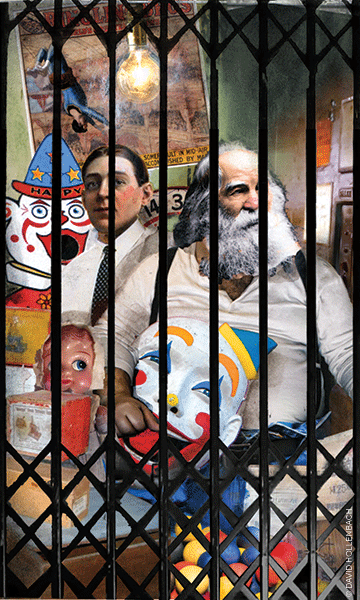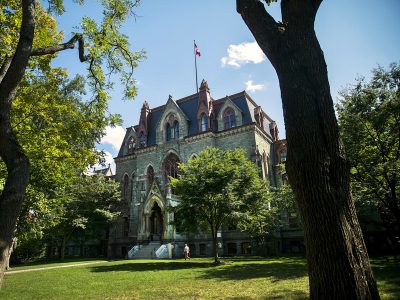
“Al stepped in and shut the door. The elevator began screeching.”
By Matt Fernandez | “I’m going on vacation,” a man announced to the trendy crowd queuing for doughnuts at the Peter Pan Bakery in Greenpoint, Brooklyn.
One of the Polish waitresses looked up at him. He was a regular here.
“To the Branhx,” he clarified.
There was something slightly off-kilter about this customer—that became clear when he paid for his doughnut with a $50 bill and told the waitress to “keep the change.” But it was hard not to grant him his point. A person really could escape this city and yet still remain within its limits. As I’d recently discovered, you didn’t even have to have escape on your mind.
When I arrived in New York to work for the summer of 2012, I thought I knew where I’d landed. From where I grew up in the Blue Ridge Mountains, the view of Manhattan could hardly have been clearer: Downtown folks were all as hip as The Strokes, Midtown belonged to the cast of The Apprentice, and the Upper West Side was your best bet at stumbling across a Kramer.
Basically, if it was in New York, it was bound to have cachet. Certainly my internship seemed to fall into that department. I’d come to work for a non-profit conservancy in Midtown that fiscally sponsored several projects around the New York City area. The conservancy assigned me to one of them: a small urban agriculture and food-access initiative in Brooklyn.
On my first day, I was told to report to the project’s office. I’m not sure what I expected, but it definitely wasn’t what I found. The address I was given led me to a dark and decrepit warehouse that was mostly filled with strange items, many of which were from old carnivals. From stacks of dilapidated telephone booths to sad-eyed dolls, the place properly belonged in a surrealist film, not a few blocks off Flatbush Avenue.
I went up to the fifth floor, which thankfully resembled something of an office. Hordes of entrepreneurs, artists, and activists—many bespectacled and tattooed—furiously tapped on MacBook Pros, undeterred by the lack of lighting and air conditioning. That is, until they saw me, in my starchy shirt and tie with a backpack and helmet in tow, whereupon they began to stare, possibly wondering if Mormon missionaries were renting space on the floor below. I was clearly overdressed.
My first assignment was to help move items from a nearby storage building into the warehouse. This required a freight elevator and the help of Al, the warehouse owner.
“Now, Al,” my boss told me, “is one of those guys who looks like an Al.”
Finding him was a challenge. Al didn’t carry a cellphone, nor did he have a computer. Instead, as if the digital revolution had never occurred, he relied on a landline in the warehouse as his primary means of communication. With our stuff ready, I unsuccessfully tried to call him there. My boss and I then had to scour the entire warehouse to find the enigmatic Al.
After searching every story, we finally found a stout man sprawled on the second floor, tucked behind a bunch of junk, rummaging for something—apparently something very important. We called out to him. He snarled back violently. Amidst the sharp, gurgling sounds his throat made, the question What? arose.
He finally jerked around, and an impressive white beard sailed down upon his protruding belly. His physical appearance recalled Walt Whitman, but his language, which was spectacularly ornamented with expletives, articulated a different sort of poetry.
At length we loaded up the freight elevator. Al stepped in and shut the door. The elevator began screeching as we slowly made our way up in near darkness.
Then I heard a something snap, and as my heart dropped, the elevator jerked to a stop. An electrical cord had been severed.
We were now dangling in the dark on an elevator that probably hadn’t been inspected since the 1930s, if that recently. Al let out his characteristic growl, a little louder this time, and unleashed a barrage of obscenities. My boss, a lanky Midwesterner, attempted to replicate Al’s sense of frustration, but his voice lacked the intrinsic vigor of the native New Yorker.
For my part, I was glancing down at the clown mask staring at me, trying to contain my laughter. Down the street they were building the Barclays Center, but I was seemingly trapped in another time, or perhaps a Luis Buñuel film.
So this is New York, I thought. And instead of fearing for my life, like my boss was, my inner English major got the best of me.
As we dangled in the elevator shaft, my thoughts drifted to Mikhail Bakhtin, the literary theorist who coined the term carnivalesque in his critique of Dostoevsky to describe moments of absurdity in which reality is seemingly suspended.
In New York, reality was suspended all the time—all the better to gawk at it.
I recalled another surreal (but more troubling) scene I’d witnessed the previous night. Against a backdrop of some of the nation’s most expensive real estate, a pant-less homeless man adorned with a Burger King crown was enthusiastically greeting well-to-do Manhattanites with a different kind of wave of his hand. But to my surprise, no one seemed to mind, and when I passed by the same intersection an hour later, the man was still there (pants back on), harassing cars.
A few days later, I learned Katie Holmes was renting an apartment several stories above that same intersection.
Much is made of New York’s relentless gentrification, its “Disneyfication,” as though the rise of the $50 million condo and the fall of the Times Square peep show comes at the expense of a grittiness that’s more authentic. But I think the city’s enduring hold on the American imagination suggests something else. It is the fundamental incoherence of life here—which the city’s ever-glossier veneer only amplifies—that explains its appeal to many wide-eyed provincials. Only in New York can you witness juxtapositions so extreme.
Back in the elevator, after contemplating for several minutes how to extricate ourselves, Al abruptly jumped out of the ceiling of the elevator cab, scaled the inner wall to the next floor, and pulled open the shaft door.
This has got to be a dream, I said to myself. A 60-year-old man with a circus beard had just performed a stunt seemingly out of Spider-Man.
Whereupon he vanished without a word.
After leaving us in the elevator for several minutes, Al emerged again, having inexplicably found an elevator technician. Where this person came from is still a mystery to me; perhaps Al magically transformed one of the many mannequins strewn about the warehouse.
After hearing a series of odd sounds, presumably caused by the technician’s attempt at repair, my boss called up, “Yo Al, don’t you think you should just let us out first?”
Al resolutely swore back at us in his thick Brooklyn accent.
After 15 more minutes filled with clashing sounds, Al and the mysterious technician dropped a ladder down, and we made our way into the dusty light of the warehouse and then out onto the street, where life went on with its usual briskness.
Days passed, and normality—if that’s the name for it—returned. Initially I considered Al and his warehouse to be vestiges of “old” New York. But the longer I stayed in the city, the more they seemed like fitting symbols for its present moment. Even as New York rapidly changes on the surface, the carnivalesque spirit of the city remains within.
As it happened, Al eventually returned my call later that night—at midnight, actually—and left an inscrutable voicemail, which remains on my phone today.
I guess you could call it a souvenir.
Matt Fernandez is a College senior.




